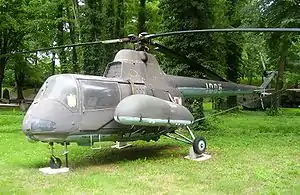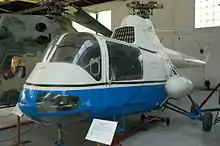PZL SM-2
The PZL SM-2 was a Polish light utility helicopter, enlarged version of license-built Mil Mi-1, developed and produced by WSK PZL-Świdnik. It was also known as the WSK SM-2.
| SM-2 | |
|---|---|
 | |
| SM-2 as military air ambulance in museum in Drzonów | |
| Role | light utility helicopter |
| Manufacturer | WSK PZL-Świdnik |
| First flight | 18 November 1959 |
| Introduction | 1961 |
| Retired | 1981 |
| Primary user | Polish Air Force |
| Produced | 1960–1963 |
| Number built | 86 + 3 prototypes |
| Developed from | Mil Mi-1 |
Design and development
From 1956, the Soviet light three-seat or four-seat helicopter Mi-1 was produced under license in the Polish WSK PZL-Świdnik works in Świdnik, under a designation SM-1 – and as much, as 1594 were manufactured. In 1957, works started in WSK PZL-Świdnik to modernize the helicopter and fit it with an enlarged, five-seat cabin. One of the design goals was to make training easier, by placing the two pilots side by side. In air ambulance role, it was easier to treat a patient inside a fuselage, than in side capsules.[1] The helicopter's main designer was Jerzy Tyrcha.[1]
The most obvious difference was a larger cabin, extended towards the front, but in fact most fuselage parts were reconstructed. The cabin had two wide side doors, sliding rearwards, being an improvement over the Mi-1, in which its automobile door could not be opened in flight and had to be removed for some purposes.[1] Unchanged were: the engine, transmission and rotor, the fuselage boom and the landing gear (only early machines had different front wheel suspension).[1][2] On contrary to the Mi-1, a headlight was movable.[1] The prototype flew first on 18 November 1959.[3] It appeared successful and a limited production started in 1960. Its take-off characteristics and performance were slightly worse, than of Mi-1/SM-1 – one of the reasons was an unsuitable carburetor intake, but it was improved only on some helicopters.[4]
Only 86 helicopters were produced, in four series, differing in details, plus three prototypes[2] (some sources say 91 or 85[3]). They were produced almost exclusively for Poland, while the SM-1 remained main export product of Świdnik at that time. The helicopter was manufactured only in one variant, and could change its role to passenger, transport, air ambulance or flying crane.[1]

.jpg.webp)
Basic variant had seats for three passengers on a rear bench and one seat next to a pilot. There were no double controls.[1] In the air ambulance configuration, single stretchers were carried in the fuselage – loaded through a special hatch in a fuselage front, on the right side. A physician could seat behind the pilot, other seats were removed.[1] Additional two injured could be carried in detachable external closed capsules on either side of the fuselage, typical for Mi-1.[1] All variants could carry additional external fuel tank 140 l on the left side, extending range to 500 km (it could not be used with side capsules). The crane variant (sometimes known as SM-2D) was used in limited numbers for search and rescue missions; it had a hydraulic winch that could lift 120 kg, in a place of a right front seat. After removal of all passenger seats, 320 kg of load could be carried.[1] They had a durability of 600 flight hours, like contemporary SM-1 helicopters.[2]
Operational history
SM-2s were used mainly by Polish military aviation – 80 were delivered, between March 1961 and 1964.[5] They were operated in small numbers by several units of the Polish Air Force and Polish Navy, mostly for liaison, artillery spotting, air ambulance tasks and others.[5] In Polish Navy they were used for search-and-rescue actions.[5] This number included a flight assigned to Internal Security Corps, later Ministry of Internal Affairs (police aviation).[5] Only two ex-military SM-2 (registration numbers SP-SXY and SP-SXZ) and the second prototype were used by civilian air ambulance service.[5] One helicopter remained in PZL-Świdnik factory (SP-SAP), and the other was acquired by the factory from the air force (SP-SFA).[5] Most SM-2s were withdrawn in late 1970s and replaced with Mil Mi-2. The last one was withdrawn from the air force in 1981, and flew until 1983 (it was preserved in the factory).[6]
Only five SM-2 were exported. One was sold to Czechoslovakia, used in 1963–70 by the Ministry of Internal Affairs (registration OK-BYK), then by Slov-Air until 1975 for internal transport (registration changed to OK-RUV).[6] Four SM-2 were sold in 1963 to Romania, used by 1975 in the military aviation (the 94th Helicopter Regiment).[6]
Four SM-2s are preserved in museums in Poland: in Polish Aviation Museum in Kraków, in Museum of Polish Arms in Kołobrzeg, Drzonów and Dęblin.[7] Apart from museums there exist SM-2 in a collection in Góraszka and in PZL Świdnik factory.[7] One is preserved at the Helicopter Museum, Weston-super-Mare, in the United Kingdom. Two other SM-2 are preserved in the Czech Republic (Prague Aviation Museum) and Romania (aviation museum in Bucharest) - both are stored (as of 2016).[7]
Operators
- Czechoslovakian Air Force
- Ministry of Internal Affairs
- Czechoslovakian National Security Guard
- Slov-Air
- Border Defence Forces
- Ministry of Internal Affairs (police aviation)
- Polish Air Force
- Polish Navy
Specifications
Data from Jane's All The World's Aircraft 1965–66[8]
General characteristics
- Crew: 1
- Capacity:
- 4 passengers or
- 1 stretcher and one attendant or
- 3 stretchers (1 internal, 2 in external nacelles)
- Length: 16.97 m (55 ft 8 in) (overall length)
- Fuselage length: 12.08 m (39 ft 8 in)
- Height: 3.30 m (10 ft 10 in)
- Empty weight: 1,890 kg (4,167 lb)
- Max takeoff weight: 2,511 kg (5,536 lb) (air ambulance, 3 stretchers)
- Fuel capacity: 250 L (66 US gal; 55 imp gal) internal, provision for 150 L (40 US gal; 33 imp gal) external auxiliary tank
- Powerplant: 1 × Lit-3 (licensed Ivchenko AI-26V) 7-cylinder radial engine, 429 kW (575 hp)
- Main rotor diameter: 14.30 m (46 ft 11 in)
- Main rotor area: 160.6 m2 (1,729 sq ft)
Performance
- Maximum speed: 170 km/h (110 mph, 92 kn)
- Cruise speed: 130 km/h (81 mph, 70 kn)
- Range: 310 km (190 mi, 170 nmi)
- Ferry range: 500 km (310 mi, 270 nmi) with auxiliary fuel
- Service ceiling: 4,000 m (13,000 ft)
- Rate of climb: 4.50 m/s (885 ft/min)
See also
Related development
Aircraft of comparable role, configuration, and era
References
- Budniak, Karol. Historia powstania śmigłowca, "Aeroplan" Nr. 5-6(122-123)/2013, p. 4-7 (in Polish)
- Budniak, Karol. Produkcja seryjna, "Aeroplan" Nr. 5-6(122-123)/2013, p. 16-21 (in Polish)
- Mikołajczuk, pp.94–90
- Skowroński (2009), p. 15
- Budniak, Karol. Użytkownicy SM-2, "Aeroplan" Nr. 5-6(122-123)/2013, p. 22-25 (in Polish)
- Budniak, Karol. Użytkownicy SM-2, "Aeroplan" Nr. 5-6(122-123)/2013, p. 26-27 (in Polish)
- Budniak, Karol. Przetrwały do naszych czasów, "Aeroplan" Nr. 5-6(122-123)/2013, p. 33-35 (in Polish)
- Taylor 1965, pp. 115–116.
- Skowroński, Grzegorz: Śmigłowiec wielozadaniowy SM-2 in: Lotnictwo z szachownicą nr.2/2004(9) (in Polish)
- Taylor, John W. R. Jane's All The World's Aircraft 1965–66. London:Sampson Low, Marston & Company, 1965.
- Mikołajczuk, Marian: Śmigłowce Mi-1/SM-1/SM-2 w polskim lotnictwie wojskowym in: Lotnictwo nr.9/2009 (in Polish)
External links
| Wikimedia Commons has media related to PZL SM-2. |
- (in Polish) http://www.sm-2.prv.pl – contains photographs.
